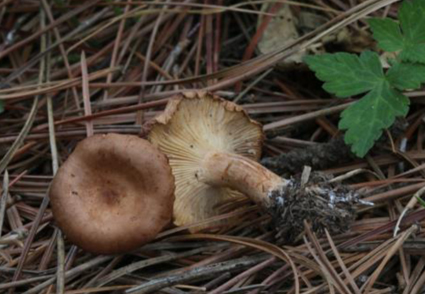Abstract
Bonomyces pseudoarnoldii is the name proposed for a new species found in north China, based on both morphological and molecular data. Phylogenetic analyses on sequence data from five different loci (ITS, SSU, LSU, tef1 and rpb2) support that this species belongs to the genus Bonomyces. Bonomyces pseudoarnoldii resembles other species of Bonomyces in its small reddish brown to pale orange pileus covered with finely to coarsely fibrillose or minute squamules, and pale white to reddish brown stipe with longitudinal fibrils. The new species is presented with illustrated description, molecular data, and comparison to related or similar species. We provide a key to the known species of Bonomyces in the world.
References
<p>Alvarado, P., Moreau, P.A., Sesli, E., Khodja, L.Y., Contu, M. & Vizzini, A. (2018) Phylogenetic studies on <em>Bonomyces</em> (Tricholomatineae, Agaricales) and two new combinations from <em>Clitocybe</em>. <em>Cryptogamie Mycologie</em> 39 (2): 149–168. https://doi.org/10.7872/crym/v39.iss2.2018.149</p>
<p>Ammirati, J.F., Parker, A.D. & Matheny, P.B. (2007) <em>Cleistocybe</em>, a new genus of Agaricales. <em>Mycoscience</em> 48: 282–289.</p>
<p>Bon, M. (1983) <em>Tricholomataceae</em> de France et d’Europe Occidentale (6 ème partie: tribu <em>Clitocybeae</em> Fay.) Clé monographique. <em>Documents Mycologiques</em> 13 (51): 1–53.</p>
<p>Boudier, E. (1894) Nouvelles espèces de Champignons de France. <em>Bulletin de la Société Mycologique de France</em> 10 (1): 59–71.</p>
<p>Dring, D.M. (1971) Techniques for microscopic preparation.<em> In: </em>Booth, C. (Ed.) <em>Methods in microbiology</em>. Vol. 4. New York: Academic Press. pp. 95–111.</p>
<p>Fries, E.M. (1818) <em>Observationes mycologicae praecipue ad illustrandam Floram Suecicam</em>, <em>Pars 2</em>. Copenhagen. 372 pp.</p>
<p>Fries, E.M. (1821) <em>Systema mycologicum I</em>. Lundæ. 520 pp.</p>
<p>Fries, E.M. (1838) <em>Epicrisis systematis mycologici: seu synopsis Hymenomycetum</em>. Upsaliæ. 612 pp.</p>
<p>Gardes, M. & Bruns, T.D. (1993) ITS primers with enhanced specificity for <em>basidiomycetes </em>– application to the identification of mycorrhizae and rusts. <em>Molecular Ecology</em> 2 (2): 113–118. https://doi.org/10.1111/j.1365-294X.1993.tb00005.x</p>
<p>Harmaja, H. (2003) Notes on <em>Clitocybe</em> s. lato (Agaricales). <em>Annales Botanici Fennici</em> 40: 213–218.</p>
<p>He, Z.M. & Yang, Z.L. (2022) The genera <em>Bonomyces</em>, <em>Harmajaea</em> and <em>Notholepista</em> from Northwestern China: two new species and a new record. <em>Mycological Progress </em>21: 26. https://doi.org/10.1007/s11557-022-01786-0</p>
<p>Hibbett, D.S. (1996) Phylogenetic evidence for horizontal transmission of group I introns in the nuclear ribosomal DNA of mushroom-forming fungi. <em>Molecular Biology and Evolution</em> 13 (7): 903–917.</p>
<p>Hillis, D.M. & Bull, J.J. (1993) An empirical test of bootstrapping as a method for assessing confidence in phylogenetic analysis. <em>Systematic Biology</em> 42 (2): 182–192. https://doi.org/10.1093/sysbio/42.2.182</p>
<p>Katoh, K. & Standley, D.M. (2013) MAFFT multiple sequence alignment software version 7: improvements in performance and usability.<em> Molecular Biology and Evolution</em> 30: 772–780. https:// doi:10.1093/molbev/mst010</p>
<p>Li, Y., Li, T.H., Yang, Z.Z., Tu, L.G.E. & Dai, Y.C. (2015) <em>Atlas of Chinese Macrofungal Resources</em>. Zhongyuan Farmers Press, Zhengzhou.</p>
<p>Liu, Y.J., Whelen, S. & Hall, B.D. (1999) Phylogenetic relationships among <em>Ascomycetes</em>: evidence from an RNA Polymerase II subunit. <em>Molecular Biology and Evolution</em> 16 (12): 1799–1808.</p>
<p>Lovejoy, R.H. (1910) Some new saprophytic fungi of the Middle Rocky Mountain Region. <em>Botanical Gazette </em>50 (5): 383–385.</p>
<p>Matheny, P.B., Wang, Z., Binder, M., Curtis, J.M., Lim, Y.W., Nilsson, R.H., Hughes, K.W., Hofstetter, V., Ammirati, J.F., Schoch, C.L., Langer, E., Langer, G., McLaughlin, D.J., Wilson, A.W., Frøslev, T., Ge, Z.W., Kerrigan, R.W., Slot, J.C., Yang, Z.L., Baroni, T.J., Fischer, M., Hosaka, K., Matsuura, K., Seidl, M.T., Vauras, J. & Hibbett, D.S. (2007) Contributions of <em>rpb2</em> and <em>tef1</em> to the phylogeny of mushrooms and allies (<em>Basidiomycota</em>, Fungi). <em>Molecular Phylogenetics and Evolution</em> 43: 430–451.</p>
<p>Nylander, J. (2004) MrModeltest 2.2. Computer software distributed by the University of Uppsala. Sweden: Evolutionary Biology Centre.</p>
<p>Page, R.D. (2002) <em>Visualizing Phylogenetic Trees Using TreeView</em>. Curr Protoc Bioinformatics. http://10.1002/0471250953.bi0602s01.</p>
<p>Rambaut, A. (2000) Estimating the rate of molecular evolution: incorporating non-contemporaneous sequences into maximum likelihood phylogenies. <em>Bioinformatics</em> 16 (4): 395–399. http://10.1093/bioinformatics/16.4.395</p>
<p>Rehner, S.A. & Buckley, E. (2005) A <em>Beauveria</em> phylogeny inferred from nuclear ITS and EF1-a sequences: evidence for cryptic diversification and links to <em>Cordyceps</em> teleomorphs. <em>Mycologia</em> 97 (1): 84–98.</p>
<p>Ronquist, F. & Huelsenbeck, J.P. (2003) MrBayes 3: Bayesian phylogenetic inference under mixed models. <em>Bioinformatics</em> 19 (12): 1572–1574. https://doi.org/10.1093/bioinformatics/btg180</p>
<p>Shangguan, T.L., Zhang, F. & Fan, L.S. (2000) Analysis on the flora of xylophyta in zhongtiao mountains. <em>Bulletin of Botanical Research </em>20: 2.</p>
<p>Stamatakis, A. (2006) RAxML-vI-HPC: maximum-likelihood-based phylogenetic analyses with thousands of taxa and mixed models. <em>Bioinformatics </em>22: 2688–2690. https://doi.org/10.1093/bioinformatics/btl446</p>
<p>Stamatakis, A. (2014) RAxML version 8: a tool for phylogenetic analysis and post-analysis of large phylogenies. <em>Bioinformatics</em> 30 (9): 1312–1313. https://doi.org/10.1093/bioinformatics/btu033</p>
<p>Stamatakis, A., Ludwig, T. & Meier, H. (2005) RAxML-III: a fast program for maximum likelihood-based inference of large phylogenetic trees. <em>Bioinformatics</em> 21 (4): 456–63. https://doi.org/10.1093/bioinformatics/bti191</p>
<p>Tolgor, B. (2016) List of Agarics and Boletoid Fungi from Eastern Inner Mongoli a (II). <em>Journal of Fungal Research</em> 14: 1. https://doi.org/10.1334/j.jfr.2014.6101</p>
<p>Vilgalys, R. & Hester, M. (1990) Rapid genetic identification and mapping of enzymatically amplified ribosomal DNA from several <em>Cryptococcus</em> species. <em>Journal of bacteriology</em> 172 (8): 4238–4246. https://doi.org/10.1128/jb.172.8.4238-4246.1990</p>
<p>Vizzini, A. (2014) Nomenclatural novelties: <em>Bonomyces</em> Vizzini, gen. nov <em>Index Fungorum</em> 159: 1.</p>
<p>Vizzini, A., Consiglio, g., Marchetti, M. & Alvarado, P (2020) Insights into the <em>Tricholomatineae</em> (<em>Agaricales</em>, <em>Agaricomycetes</em>): a new arrangement of <em>Biannulariaceae</em> and <em>Callistosporium</em>, <em>Callistosporiaceae</em> fam. nov., <em>Xerophorus stat</em>. nov., and <em>Pleurocollybia</em> incorporated into <em>Callistosporium</em>. <em>Fungal Diversity</em> 101: 211–259. https://doi.org/10.1007/s13225-020-00441-x</p>
<p>White, T.J., Bruns, T., Lee, S. & Taylor, J. (1990) Amplification and direct sequencing of fungal ribosomal RNA genes for phylogenetics. <em>In</em>: Innis, M., Gelfand, D., Sninsky, J. & White, T. (Eds.) <em>PCR Protocols: A guide to Methods and Applications</em> 18 (1). Academic Press. pp. 315–322. https://doi.org/10.1016/B978-0-12-372180-8.50042-1</p>


